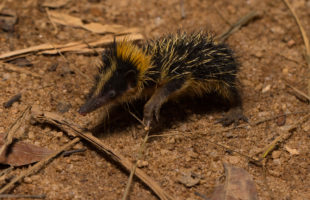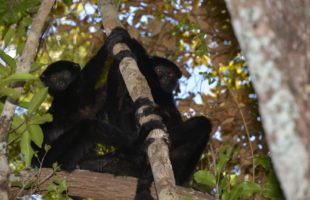Most animals that only occur in Madagascar are very special. Also the streaked tenrec has its peculiarities and is considered to be the most highly specialized of all 31 tenrec species. They belong to the hedgehog tencres – they have spines like hedgehogs, but are actually not even related to the hedgehogs. Also the spines are not completely genuine: It …
LesenThe gardeners of the forest: Red-bellied lemurs
One does not often meet red-bellied lemurs (Eulemur rubriventer) in Madagascar, but they play an important role in the rainforest’s fragile ecosystem. Only male wear the eponymic red belly, females are white or cream colored on chest and belly. Males also have white fur below their eyes which lacks in females. At average, red-bellied lemurs weigh one and a half …
LesenAn east-west-conflict: Red-fronted lemurs
In red-fronted lemurs, colour has been distributed inequally: Only males bear the eponymic red forehead. In females, this area is grey coloured. Both genders weigh between two and three kilograms and become only half a meter in size, measured without tail. Until 2008, scientists thought the red-fronted lemur to be a subspecies of the similar looking rufous brown lemur or …
LesenMadagascar’s famous ring-tailed lemurs
They are the unofficial mascots of Madagascar and probably the most famous Malagasy lemurs: The ring-tailed lemurs (Lemur catta). Their portraits grace the logo of Madagascar National Parks (MNP), countless t-shirts, and company emblems. A full-grown ring-tailed lemur weighs maximally 3.5 kg. The ringed tail is 60 cm longer than the whole body which is only 40-45 cm. In contrast …
LesenThe fruit gourmets: Black-and-white Ruffed Lemurs
Many people know them from zoos and animal parks: Black-and-white ruffed lemurs (Varecia variegata). Besides Red Ruffed Lemurs and the Indri, they belong to the largest lemurs with a head-torso length of 40 to 60 cm, an additional 60 cm added for the tail. Weights of 3 to 4 kg are the average. Black-and-white ruffed lemurs exclusively live in the …
LesenDie singenden Lemuren: Indris
Ihre Gesänge gehören zu den eindruckvollsten, die die Tierwelt zu bieten hat: Man kann die Stimmen der Indris (Indri indri) kilometerweit durch den Wald schallen hören, und sie tragen eine eigentümliche Traurigkeit mit sich. Angeführt und begonnen wird der Gesang stets vom Elternpaar einer Familie, das damit sein Revier absteckt, aber auch mit anderen Familien kommuniziert und vor Bedrohungen wie …
LesenThe left-handed lemurs: Coquerel’s sifakas
With their typical teddy bear-like appearance, they wrap many travellers around their fingers: Coquerel’s Sifakas (Propithecus coquereli) wear a plush, snow-white fur, whereby the upper sides of the arms and thighs as well as the chest are deeply chocolate brown colored. With up to a half meter head-torso-length – in addition, another half meter tail – as well as approximately …
LesenThe angels of the forest: Silky sifakas
The Silky Sifaka (Propithecus candidus) is one of the most beautiful and special lemurs of Madagascar, but also one of the rarest. There are only about 250 sexually mature silk sifakas left in Madagascar, otherwise they do not occur anywhere else in the world. For comparison: In Asia alone there are still around 3000 to 5000 full-grown specimens of tigers …
LesenThe rarest lemur on Earth: Perrier’s Sifaka
Practically the counterpart to the white Silky Sifaka is the closely related Black Sifaka or Perrier’s Sifaka (Propithecus perrieri). With a height of 85 to 92 cm and a weight of three to six kilograms, it belongs to the larger lemurs, with the tail accounting for up to 46 cm of its total length. Suitably to the name these animals …
LesenSecret kings of the North: Golden crowned sifakas
In an incredibly hot, dry and inaccessible area in north-eastern Madagascar live white lemurs, which owe their name to the golden fur on their heads: the Golden Crowned Sifakas (Propithecus tattersalli). The secret kings of the north reach a height of just 95 cm with a weight of 3.5 kg, whereby still further 45 cm of tail come in addition. …
Lesen MADAMAGAZINE Your Magazine about Madagascar
MADAMAGAZINE Your Magazine about Madagascar










